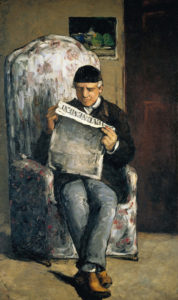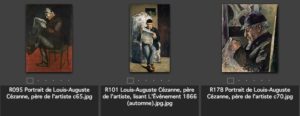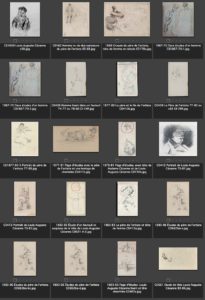R101 – Louis-Auguste Cézanne, père de l’artiste, lisant l‘Evénement, automne 1866 (FWN402)
Pavel Machotka
(Cliquer sur l’image pour l’agrandir)
Neither the originality of pure knife painting nor its success on this small scale seduced Cézanne into adopting it as his sole style; in the couillarde phase he could be equally vehement with his brush, and in large paintings the brush was actually the more natural choice. Youthful ambition could be satisfied just as well by a striking format, an important subject, or a monumental treatment, as by a bravura use of the knife. Cézanne’s large portrait of his father, Louis-Auguste Cézanne, père de l’artiste, lisant l’Evénement, embodies just such an ambition, and uses these means; in part it also honors his father (and, we shall see, himself). The painting relies on the brush for the most part, and its broad sweeps remain distinct, their vigor undiminished. The obstinate firmness of the composition and pose reflect Courbet, as Fry has pointed out, as does the brown-black tonality[1]; the tall, narrow format—fully 2 meters in height—places the figure respectfully in distinguished isolation.
It is perhaps surprising that so ambitious a picture should come off so well. In some respects it is intended to satisfy too many wishes: it clearly represents admiration for his father, but it is also meant to reveal a satisfaction with his own work, which hangs on the wall, and to suggest, to those who could read the hint, that the father read the newspaper which carried Zola’s articles on that year’s Salon rather than the paper he actually did read. Yet the whole is both good-humored and grave, and technically successful; the space is ordered and convincing, receding both obliquely, through the feet, thighs and armrests, and by superposition of planes—from the hands to the newspaper, and from there to the torso, the back of the chair, and the wall. In color it is luminous and balanced, pivoting on a cool, neutral grey in the trousers, balanced between the warm browns of the wall and the cool greens of the still life[2].
[1] Roger Fry, Cézanne: a portrait of his development, p. 18.
[2] See Sucrier, poires et tasse bleue .
Source: Machotka, Cézanne: the Eye and the Mind.
Voir aussi le commentaire de ce portrait par Jean Arrouye.
Louis-Auguste Cezanne fait l’objet de 3 autres tableaux et d’une vingtaine de dessins :




